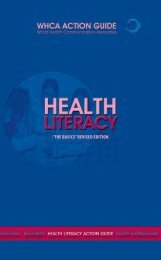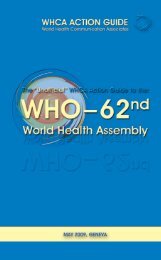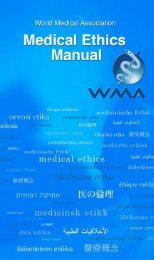Part 1 'the basics' - World Health Communication Associates
Part 1 'the basics' - World Health Communication Associates
Part 1 'the basics' - World Health Communication Associates
You also want an ePaper? Increase the reach of your titles
YUMPU automatically turns print PDFs into web optimized ePapers that Google loves.
to counteract the negative influences of industries—tobacco, alcohol and fast food<br />
companies—which glamourise and promote unhealthy products and lifestyles.<br />
Home and community settings — People are called upon to make daily ‘health’<br />
decisions in their homes and communities. Families, peer groups and communities are<br />
primary sources of health information. They help to shape functional health literacy<br />
skills related to product and service choices. These sources can provide important<br />
information about health-promoting, health-protecting and disease-preventing<br />
behaviours, as well as ‘alternative therapies’, self- and family care, available support<br />
services and first aid.<br />
Workplace settings — By providing clear and consistent health messages to<br />
employees, employers can help prevent accidents and lower the risk of industrial or<br />
occupational diseases. <strong>Health</strong>-promoting work environments go further and address<br />
lifestyle choices, such as alcohol and drug use and stress factors, including job security<br />
and work–life balance.<br />
Policy making arenas — Policies on all levels—institutional, community,<br />
national and regional—shape the social and structural factors which determine<br />
health literacy and health. The engagement of citizens in policy making processes are<br />
fundamental democratic principles. A key trend in many health system reforms is the<br />
empowerment of patients and the development of patient-centred care.<br />
building individual skills<br />
Skills and Abilities<br />
Building health literacy skills and abilities is a lifelong process, and noone is ever<br />
totally health literate (or illiterate 1 ). People develop their health literacy over time<br />
and from a wide variety of sources. These may include their family and work settings;<br />
primary, secondary, higher and adult education; health providers; print and on-line<br />
health information; the media; and a wide variety of community-based resources,<br />
such as support groups to assist in quitting smoking.<br />
1 This guide intentionally avoids use of the term ‘health illiteracy’, as it is both inaccurate and an<br />
emotionally loaded term which all too often causes stigma and shame.<br />
Section 1: wHat iS HealtH literacy? 11






